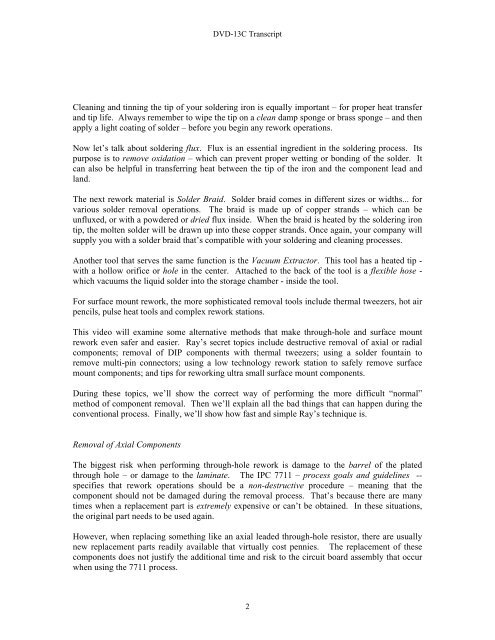Create successful ePaper yourself
Turn your PDF publications into a flip-book with our unique Google optimized e-Paper software.
DVD-13C <strong>Transcript</strong>Cleaning and tinning the tip of your soldering iron is equally important – for proper heat transferand tip life. Always remember to wipe the tip on a clean damp sponge or brass sponge – and thenapply a light coating of solder – before you begin any rework operations.Now let’s talk about soldering flux. Flux is an essential ingredient in the soldering process. Itspurpose is to remove oxidation – which can prevent proper wetting or bonding of the solder. Itcan also be helpful in transferring heat between the tip of the iron and the component lead andland.The next rework material is Solder Braid. Solder braid comes in different sizes or widths... forvarious solder removal operations. The braid is made up of copper strands – which can beunfluxed, or with a powdered or dried flux inside. When the braid is heated by the soldering irontip, the molten solder will be drawn up into these copper strands. Once again, your company willsupply you with a solder braid that’s compatible with your soldering and cleaning processes.Another tool that serves the same function is the Vacuum Extractor. This tool has a heated tip -with a hollow orifice or hole in the center. Attached to the back of the tool is a flexible hose -which vacuums the liquid solder into the storage chamber - inside the tool.For surface mount rework, the more sophisticated removal tools include thermal tweezers, hot airpencils, pulse heat tools and complex rework stations.This video will examine some alternative methods that make through-hole and surface mountrework even safer and easier. Ray’s secret topics include destructive removal of axial or radialcomponents; removal of DIP components with thermal tweezers; using a solder fountain toremove multi-pin connectors; using a low technology rework station to safely remove surfacemount components; and tips for reworking ultra small surface mount components.During these topics, we’ll show the correct way of performing the more difficult “normal”method of component removal. Then we’ll explain all the bad things that can happen during theconventional process. Finally, we’ll show how fast and simple Ray’s technique is.Removal of Axial ComponentsThe biggest risk when performing through-hole rework is damage to the barrel of the platedthrough hole – or damage to the laminate. The <strong>IPC</strong> 7711 – process goals and guidelines --specifies that rework operations should be a non-destructive procedure – meaning that thecomponent should not be damaged during the removal process. That’s because there are manytimes when a replacement part is extremely expensive or can’t be obtained. In these situations,the original part needs to be used again.However, when replacing something like an axial leaded through-hole resistor, there are usuallynew replacement parts readily available that virtually cost pennies. The replacement of thesecomponents does not justify the additional time and risk to the circuit board assembly that occurwhen using the 7711 process.2
















